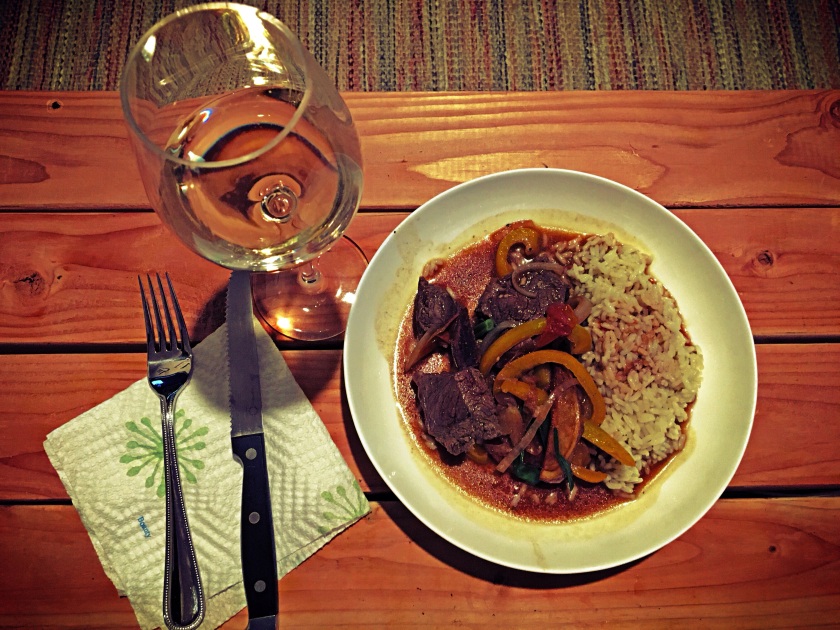
This was my first Mother’s Day away from my mom, but my first with my new Mother-in-Law. As a gift, she told me she wanted me to make a proper Cuban meal. Since I’ve recently mastered arroz con pollo, I thought I’d give it another go. I still think the real gift was for me, a full unsupervised day in a giant kitchen with a gas stove and miles of counter space!
I served the arroz con pollo with an avocado salad and platanitos en tentacion.
Arroz con Pollo:
1 package bone-in chicken thighs with the skin on (about 4-6 thighs)
1 package Spanish chorizo
1 8oz package cubed ham
1 green bell pepper, chopped
1 large yellow or white onion, chopped
6 cloves garlic, chopped
3 tbsp olive oil
1 10oz jar manzanilla olives
1 4oz jar sliced pimientos
1 14oz package arborio or Valencia rice
3 sachets sazon Goya
1 cup dry white wine
1 12oz beer
2 bay leaves
1 teaspoon ground cumin
1 teaspoon ground coriander
1 cube chicken bouillon
2 tablespoons tomato paste
1 28oz can chopped tomatoes
Few strands saffron (optional)
Salt and Pepper to taste
Place the chicken thighs in a large pot with one quartered onion, one bay leaf, the cube of chicken bouillon and a sprinkle of black pepper. Cover with cold water and bring to a boil, then turn down the heat and let them simmer until cooked through. Once the chicken has cooked, set on a plate, discard the onion and bay leaf and reserve the cooking liquid.
Heat the oil in a large, heavy pot. I use a 5 1/2 quart Le Creuset, but feel free to go with something a bit larger. Add the garlic and cook over medium high heat until fragrant. Add the onion and green pepper and cook, stirring often until the onion is translucent.
Add the second bay leaf, cumin, and coriander and stir.
Add the cubed ham and sliced chorizo. Stir.
Add the package of arborio rice and stir to combine ingredients.
Pour in the canned tomatoes, sazon goya, tomato paste, white wine and beer. Stir.
Add the chicken thighs and enough of the reserved broth to cover the ingredients in the pot. Bring to a boil.
Once the mixture is boiling, reduce the heat and stir.
Add the drained olives, pimientos, and saffron, if you are using it.
The mixture should be simmering. Watch it closely and stir often as the rice absorbs the liquid fairly quickly. From this point on treat the rice much like you would a risotto, gradually adding more liquid and stirring until the rice is the right texture. Remember that this will be slightly mushier in texture than a traditional risotto.
Once the liquid is absorbed and the rice is at your desired tenderness, season with salt and pepper, remove from heat and allow it to sit for 15 minutes. Serve.
Serves 8, generously.
Platanitos en tentacion:
3 overripe plantains, peeled, cut in half and lengthwise
2 tablespoons brown sugar
1 tablespoon white sugar
1 teaspoon cinnamon
3 tbsp rum
4 tbsp butter
Preheat the oven to 375.
Grease a small, glass baking or pie pan.
Place the plantains in the pan and sprinkle the cinnamon and sugars over them.
Cut the butter into small pieces and drop them around the plantains. Pour the rum over the mixture.
Bake for 45min to 1 hour.
Notes:
-You can switch out the olives in the arroz con pollo for peas. I love olives, so I use them instead of the peas.
-You can also top the arroz con pollo with asparagus. Growing up, everyone seemed to use canned asparagus. I don’t recommend that. It’s weird. However, it might be nice to top with blanched or grilled asparagus, if you are so inclined.




